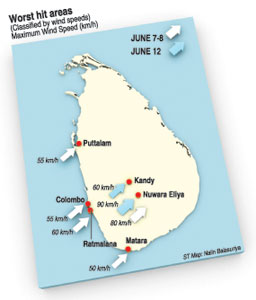News
Worst of the monsoon season is over
The Department of Meteorology says the worst of the southwest monsoon is over but the season would continue until mid-September, bringing spells of rain which may strengthen from time to time.
The southwest monsoons affect mainly the central, Sabaragamuwa and Western provinces, and the Galle and Matara districts.
“At the beginning, usually during the first three weeks, bad weather conditions tend to be rigorous. However, the worst of it is now over,” said Mr S.R Jayasekera, director of weather forecasting at the Department of Meteorology.

The southwest of the country was recently hit by a wave of heavy rains and strong winds, which took the lives of 58 people and left five others missing, according to the Disaster Management Centre.
Most of these victims were fishermen, and the Met Department has come under fire for failing to adequately warn fishermen ahead of the June 7 inclement weather. Mr Jayasekera said extreme weather events and their magnitude were hard to predict, even with the correct technology.
“This particular incident was not necessarily a problem with technology. Extreme weather events occur and they cannot always be correctly forecast. This is not the only country in which this happens,” he said. Strong winds and rains brought about during the monsoon season are usually the result of three possible occurrences, according to Mr Jayasekera. Jet stream currents reaching ground level, the convergence of wind currents and cyclonic activities such as depressions in the Bay of Bengal result in inclement monsoonal weather.
The jet stream, which is a part of the monsoon season, was responsible for the recent havoc in the southwest of the country. The jet stream is made of ribbons of very cold, strong winds that can reach speeds of about 225km an hour. They travel 8-15km above the surface of the earth.
Mr Jayasekera said the adverse weather in Nuwara Eliya on June 12 showed how the jet stream affected climate. “While Nuwara Eliya experienced wind speeds of up to 90 km/h, Colombo was not touched. This is because Nuwara Eliya is hill country and is therefore more vulnerable to the jet stream,” he said.
It was difficult to predict the effect of the jet stream on the earth’s surface. “We have no way of knowing whether the jet stream will touch ground level. The odds are 50-50. Fortunately, the jet stream has now passed the area and no longer poses a threat. But we now have to watch out for the convergence of wind currents or cyclonic activities in the Bay of Bengal,” Mr Jayasekera said.
Probe on failure to give adverse weather warnings
Media, public representations only if necessary
The three-member Committee of Inquiry to look into the deaths of fishermen and the reason for the failure to give early adverse weather warnings will consider getting representations from the media and the public, only if it is necessary.
On Friday (21), when the President met Editors of media institutions, he said media personnel too can make representations to the committee. The committee led by former Director General Dr. A. W. Mohottala was appointed on instructions given by President Rajapaksa.However, Dr. Mohottala said the committee will consider getting representations only if it’s necessary.
“The report will be submitted in two week’s time,” he said. Last week, Fisheries Minister Dr. Rajith Senaratne said that media play an important role in delivering early weather warnings.
“Fishermen in day trawlers carry small radios and listen to weather forecasts. During the day they watch weather forecasts on television. It is important to ascertain whether the forecasts were received by the media before the fishermen went out to sea,” he said.
Despite two weeks after the death of 58 fishermen and another five still missing at sea from the deadly storm on June 8, authorities still have not given compensation to the families of the fishermen.
When contacted, Fisheries Ministry spokesman Narendra Rajapaksa said the Ministry will distribute the compensation to families once it is released by the Treasury. “We hope that the funds will be received by next week or two,” he said.
Follow @timesonlinelk
comments powered by Disqus

